-
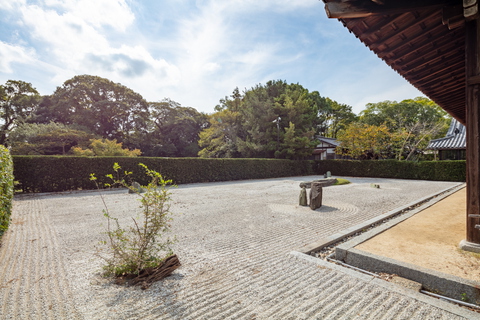
1Shidoji Temple
Shidoji, or the “Temple of Wish Fulfilment,” is the 86th sanctuary on the 88-temple Shikoku Pilgrimage. Located in the city of Sanuki, it welcomes a steady stream of pilgrims nearing the end of their long journey. Shidoji has spacious, forested grounds, and a number of auxiliary halls and other structures. The temple is entered through the Niomon, or Gate of the Guardian Kings, which is flanked by a pair of statues representing fierce guardian deities. These are believed to have been carved by Unkei (1150–1223), a master sculptor of Buddha statues whose work includes several figures now designated National Treasures. The gate itself was donated to the temple in 1671 by the daimyo lord of the Takamatsu domain, who in that year also had a new Main Hall built at Shidoji. The gate and hall are both designated Important Cultural Properties. Another symbol of the temple is its bright red 33-meter pagoda, which was added in 1975. Also of interest is the Muzentei, a dry garden designed by the renowned landscape architect Shigemori Mirei (1896–1975).
The temple’s principal deity is Juichimen Kannon, the eleven-headed bodhisattva of compassion. The statue depicting this deity was carved out of a single piece of hinoki cypress in the Heian period (794–1185) and is revealed to the public on only one day every year: July 16. Another statue at the temple, the Datsueba, is somewhat less elusive. It is displayed on the 17th day of every month in the Datsueba Hall. Datsueba is a character in Japanese folklore who awaits the dead in the Buddhist underworld, where the souls of the deceased must cross the Sanzu River to reach the afterlife. Datsueba preys on those who have crossed, snatching their clothes and hanging them on a tree. She then determines the weight of a person’s sins by inspecting the condition of their clothes, and doles out various punishments before letting her victims pass to the palace of Enma, the king of the underworld, to receive his judgment. Another hall at Shidoji is dedicated to Enma, enshrined in the form of the eleven-headed Kannon. At Shidoji the two are believed to be incarnations of the same deity. The Enma statue can also be viewed on the 17th day of the month.More details
-
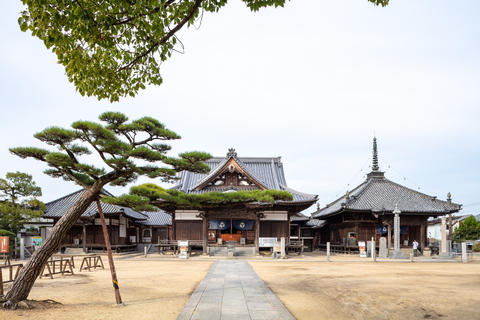
2Nagaoji Temple
Nagaoji, a temple of the Tendai school of Buddhism, is the 87th site on the 88-temple Shikoku Pilgrimage. Its history is believed to have begun in the year 739, when a priest named Gyoki (668–749) visited the site during his journeys around Shikoku. Nagaoji also claims an association with Kukai (774–835), the presumed founder of the Shikoku Pilgrimage, who is said to have conducted rituals here in his youth before traveling to China to study esoteric teachings. After returning to Japan, Kukai visited Nagaoji again and had its grounds expanded. The ancient halls of the temple were lost to fire and war long ago; the current configuration of buildings dates to the Edo period (1603–1867), when Nagaoji received the protection and favor of the daimyo lords of the Takamatsu domain. The Main Gate, in which the temple bell hangs, was built in 1694 and is one of the oldest surviving structures on the grounds.
Other sites of interest include the East Gate, which was moved to its current spot in 1913 from the historic Ritsurin Garden in Takamatsu, and a monument to Lady Shizuka (1165–1211), a tragic figure whose story has been recounted in many epic plays and chronicles. Shizuka was the mistress of Minamoto no Yoshitsune (1159–1189), a warrior renowned for his military prowess, who became a wanted man after falling out with his family. After the lovers parted ways to evade their captors, Shizuka and her mother are said to have visited Nagaoji, where they decided to become Buddhist nuns. The hair Shizuka shaved off to indicate her commitment is believed to be buried under a mound near the monument.More details
-
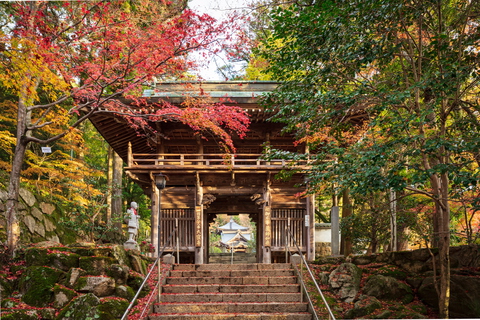
3Okuboji Temple
Okuboji, a sanctuary of the Shingon school of Buddhism, is the 88th and final temple on the Shikoku Pilgrimage. Its grounds cover the side of the 774-meter Mt. Nyotai, near the border between Kagawa and Tokushima prefectures, and attract pilgrims as well as casual visitors, many of whom include Okuboji in a tour of the Three Rising Temples—the last three temples on the pilgrimage. According to the temple’s own history, it was founded in the early eighth century, when a priest named Gyoki (668–749) visited the current site of Okuboji during his journeys around Shikoku. The temple also claims an association with Kukai (774–835), the presumed founder of the Shikoku Pilgrimage, who is said to have conducted ascetic training in a cave on the steep, distinctively shaped cliffside behind the Main Hall. In this cave, Kukai carved a likeness of Yakushi, the Buddha of medicine and healing, offered a staff that had passed through the three great lands of Buddhism—India, China, and Japan—and named the place Okuboji (“Temple of the Great Hollow”).
As most Shikoku pilgrims complete their long journey at Okuboji, the temple grounds include a repository for walking sticks that pilgrims dedicate to the temple before returning home. The items in this repository, which is located next to the Daishi Hall, are disposed of ritually by burning them every spring and summer. Visitors to Okuboji can get a feel for the pilgrimage by descending into a room under the Daishi Hall, where 88 statues that represent the deities of the temples along the pilgrimage route are enshrined. Underneath the floor in front of each statue is a bag of sand from the temple enshrining the depicted deity. This sand represents the sacred ground of the temple and allows the person who steps on it to receive the same blessings as a visitor to the actual sanctuary. This miniature pilgrimage was established to accommodate those unable to travel the actual route due to constraints of health or time.
Located some 450 meters above sea level, Okuboji occasionally receives snowfall in winter. In November, just before the coldest time of the year, the temple attracts crowds of visitors who come to view the autumn foliage of the ginkgo and maple trees that grow throughout the grounds.More details
-

4The Glove Industry of Higashi-Kagawa
The city of Higashi-Kagawa in eastern Kagawa Prefecture is the center of the Japanese glove industry. It hosts most of the country’s major manufacturers, which together produce approximately 90 percent of the gloves made in Japan. The history of the industry here can be traced back to 1888, when Futago Shunrei (1853–1891), a former Buddhist priest who was born in the area, started a glove-making business in Osaka to support his newlywed wife, with whom he had moved to the city. After Shunrei’s untimely death at the age of 39, his cousin Tanatsugu Tatsukichi (1874–1958) took over the business.
The region around Higashi-Kagawa had traditionally subsisted on salt production, but by the late 1800s this industry was in decline. The people fell on hard times, and the mayor of a local village decided to ask the Osaka-based Tanatsugu for help. The glove-maker agreed to move his business to his home region, and in 1899 established a new factory in what is now Higashi-Kagawa together with Futago Shunrei’s widow. Their enterprise proved a success, and Tanatsugu actively expanded it by introducing Western technology and advanced machinery, obtaining some 24 international patents in the process.
World War I provided a significant spark for the Japanese glove industry. While the United Kingdom and Germany, the two largest glove-producing countries at the time, were busy waging war, Japanese factories were inundated with military orders from around the world. The glove industry of Higashi-Kagawa prospered, and was later able to endure hardships such as the Great Depression and World War II. From the 1950s onward, boosted by the Korean War and high economic growth in the postwar period, Japan became the world’s largest glove producer. While those glory days are far behind it, the glove industry of Higashi-Kagawa remains vibrant. Its products range from regular mittens to wedding gloves and baseball, golf, ski, and other sports gloves, and some producers have recently expanded into related fields such as bags and leather accessories.
The Higashi-Kagawa Glove Museum, opened in 2008, informs visitors about the history and craftsmanship of gloves. Its displays include antique tools and equipment, gloves from around the world, materials, and explanations of the artisanship involved in making the perfect glove. After viewing the exhibits, visitors can try on a wide variety of locally made gloves at the outlet store next door.More details
-
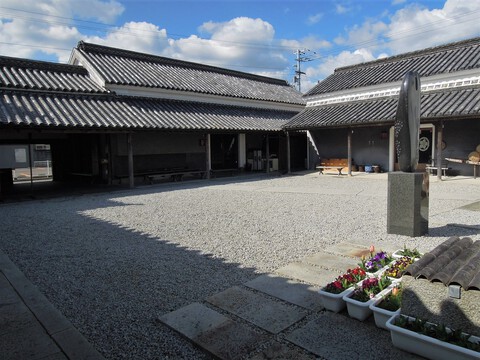
5Sanshu Izutsu Residence
The Sanshu Izutsu Residence in the city of Higashi-Kagawa was once home to one of the most prosperous families in eastern Kagawa Prefecture. The Sano family operated multiple businesses, including soy sauce and sake brewing, and owned large tracts of land in the area from the Edo period (1603–1867) to the first few decades of the twentieth century. Their expansive estate, which consists of a residential building, storerooms, and warehouses, was completed in the early Meiji era (1868–1912) and thoroughly renovated in 2001. It now houses a variety of facilities, including a museum, a tourist information center, and a souvenir shop. The residential building, including a detached cottage in the back and a central garden with trees that are up to 200 years old, lets visitors imagine the lifestyle of a wealthy merchant more than a century ago. The fire-resistant storehouse (kura) adjacent to the residential building now functions as a shop and restaurant. The facility also hosts regular workshops themed on the artisanal traditions of Higashi-Kagawa, which include mitten decoration and making confections with a type of fine-grained sugar (wasanbon) traditionally produced in this area.
More details
-
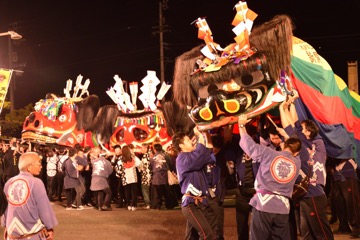
Lion Dance
The lion dance originally came from China but has been performed in Japan for over a thousand years. Performers wear lion costumes and mimic the movements of a lion in a dance that banishes evil and brings in good luck and fortune. Lion dances are performed throughout Japan at festivals and for celebrations, and there are said to be some 8,000 varieties in Japan. Of these, over 1,200 distinct varieties of lion dance are performed in Kagawa Prefecture alone.
The lion dances of Kagawa are unlike those performed elsewhere. While many lion dance masks are made of wood, most of the masks in Kagawa are made of paper. The ears stand straight up, the eyes roll around, and the mouths have sharp teeth. In Kagawa, the bells used to accompany the lion dance are big, over thirty centimeters tall. The lion dance is one of the liveliest performances of autumn festivals in Kagawa Prefecture, and with over a thousand variations of the dance to enjoy, you will never get bored.
We hope you have a chance to see several, so you can compare the differences, and come to know the fascination of the lion dance.
For more information please see: https://shishimaiouendan.comMore details
